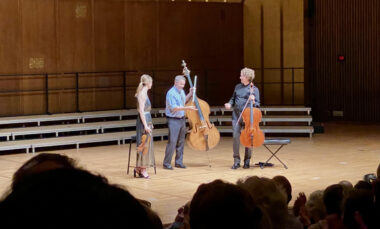 United States Bach, Meyer: Tessa Lark (violin), Josh Roman (cello), Edgar Meyer (double bass). Presented by Cal Performances, Hertz Hall, University of California, Berkeley, 20.10.2024. (HS)
United States Bach, Meyer: Tessa Lark (violin), Josh Roman (cello), Edgar Meyer (double bass). Presented by Cal Performances, Hertz Hall, University of California, Berkeley, 20.10.2024. (HS)

J.S. Bach – Sonata for Viola da Gamba in G major, BWV 1027
Edgar Meyer – Trio 1986, Trio 1988, Trio 2024
Edgar Meyer may be best known as the string bass player with whom an eclectic range of A-list soloists wants to make music. He has appeared with and recorded with the likes of cellist Yo-Yo Ma, the tabla virtuoso Zakir Hussain, the Emerson Quartet, the jazz bassist Christian McBride and such bluegrass royalty as Béla Fleck (banjo), Mark O’Connor (fiddle) and Chris Thile (mandolin). Grammy awards often resulted.
He is also a composer to be reckoned with. Commissions have included music for Emanuel Ax, Joshua Bell, Hilary Hahn and the Boston Symphony Orchestra. His first extended composition (beyond lead sheets for bluegrass songs) dates from the mid-1980s – a chamber music trio written for the unusual combination of violin, cello and bass. Trio 1986 debuted at the Santa Fe Chamber Music Festival with violinist Daniel Phillips, cellist Carter Brey and Meyer on double bass.
Two more followed at Santa Fe, but none were recorded commercially. He has not written again for the grouping until this year, when he partnered with violinist Tessa Lark and cellist Josh Roman and added a brand-new one. Trio 2024, to be recorded shortly along with the other three, made a delightful impression Sunday afternoon, capping an engrossing recital presented in Hertz Hall.
Lark, a musical polymath who has performed with major symphony orchestras and jazz and bluegrass musicians, displayed a natural affinity between her playing and Meyer’s, especially with the bluegrass elements that color his music. Those flavors were discernible in Meyer’s pieces on Sunday’s program, and Lark’s affinity for the rhythms and nuances of phrasing brought the music to a high level.
Cellist Roman, a solo artist and a composer, has garnered attention for his experience recovering from long COVID-19, which derailed his career in 2021. You would never know it from his incisive, virtuosic playing on Sunday, including some rapid-fire unison moments that could not have been more dazzling.
Impressively, these three musicians played nearly two hours of music from memory and with zero vibrato, losing none of their impeccable intonation and tone.
The program began with J.S. Bach’s Sonata for Viola da Gamba in G major. With Meyer playing the basso continuo and Lark and Roman sharing the harpsichord’s two lines, it worked splendidly as a sort of palate-refresher for what was to come. Meyer’s trios do not follow Bach’s slow-fast-slow-fast pattern exactly, but they do reflect a similar transparency of texture, music moving in counterpoint and an ear-enchanting penchant for melodic lilt.
Trio 1986 began by laying down a pulsing drone and floating a simple melodic idea over it, the pairings changing as the movement evolved. The second movement set an ostinato in motion with increasingly elaborate decorations before settling into a sort of hymn. The third movement sashayed with accents on the afterbeat and a sassy tune that wound around it, before the finale, which raced through rapid rhythms and flight-of-the-bumble-bee level string playing at the climax.
Trio 1988 achieved more complexity, without losing the easy-to-like rhythms and tunes that Meyer does so well. There is more going on, more layers to the music, more drama, trickier time signatures. One can hear a deeper command of the signature elements of his music – chorales of intimate beauty, jaunty rhythms, virtuosic requirements that do more than just show off technique – which flow with inevitability and finish in a gush of breathlessly fast unison playing.
The new one, Trio 2024, felt the most assured, marked by an expansiveness that set it apart from the earlier music and a sense that extra notes have been whittled away to get to an essence. Elements of some of the music Meyer has played with others in recent years, including hints of Indian music and jazz, seep in around the edges like ‘other’ musical worlds and add seasoning without become prominent. Bluegrass rhythms and gestures also felt totally absorbed into the picture.
Although Meyer cautioned the audience that the slow movement was still a work in progress, it felt complete, and not particularly short. But heck, if he has ideas to develop it further, I’ll queue up to hear it.
The encore returned to Bach in a note-by-note performance of ‘Wachet auf, ruft uns die stimme’, enlivened with a delicately applied rhythmic pulse that called to mind a laid-back version of bluegrass. It was reminiscent of a version Meyer played with Thile (on mandolin) and Ma (on cello). The bass playing pizzicato, Lark bowing the familiar tune and Roman the ‘tenor obbligato’ on his cello created three minutes of magic.
Harvey Steiman
